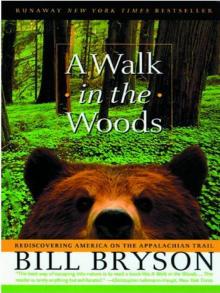- Home
- Bill Bryson
A Walk in the Woods
A Walk in the Woods Read online
Copyright
About
Dedication
Foreword
Part 1
Chapter 1
Chapter 2
Chapter 3
Chapter 4
Chapter 5
Chapter 6
Chapter 7
Chapter 8
Chapter 9
Chapter 10
Chapter 11
Chapter 12
Part 2
Chapter 13
Chapter 14
Chapter 15
Chapter 16
Chapter 17
Chapter 18
Chapter 19
Chapter 20
Chapter 21
Copyright
* * *
This book was
copied right, in
the dark, by
Illuminati.
About The
e-Book:
* * *
TITLE: A Walk in the Woods
AUTHOR: Bryson, Bill
ABEB Version: 2.6
Hog Edition
A WALK IN THE WOODS
BILL BRYSON
Dedication
To Katz of course
Foreword
THIS BOOK DESCRIBES the author’s experience while walking the Appalachian Trail and reflects his opinions relating to those experiences. Some names and identifying details of individuals mentioned in the book have been changed to protect their privacy.
A Walk in the Woods is a laugh-out-loud account of an outrageously rugged hike by a beloved comic author.
Bill Bryson decided in 1996 to walk the 2,100-mile Appalachian trail. Winding from Georgia to Maine, this uninterrupted ‘hiker’s highway’ sweeps through the heart of some of America’s most beautiful and treacherous terrain. Bryson risked snake bite and hantavirus to trudge up unforgiving mountains, plod through swollen rivers, and yearn for cream sodas and hot showers. This amusingly ill-conceived adventure brings Bryson to the height of his comic powers, but his acute eye also observes an astonishing landscape of silent forests, sparkling lakes, and other national treasures that are often ignored or endangered.
Bill Bryson was born in Des Moines, Iowa, in 1951. A backpacking expedition in 1973 brought him to England where he met his wife and settled until 1995. He now lives in Hanover, New Hampshire, with his wife and four children.
The Lost Continent, Bill Bryson’s hilarious first travel book, chronicled a trip in his mother’s Chevy around small town America. Since then, he has written several more about the UK and the US, including notable bestsellers, A Walk in the Woods, I’m A Stranger Here Myself, In a Sunburned Country and, most recently, A Short History of Nearly Everything.
Part 1
Chapter 1
Not long after I moved with my family to a small town in New Hampshire I happened upon a path that vanished into a wood on the edge of town.
A sign announced that this was no ordinary footpath but the celebrated Appalachian Trail. Running more than 2,100 miles along America’s eastern seaboard, through the serene and beckoning Appalachian Mountains, the AT is the granddaddy of long hikes. From Georgia to Maine, it wanders across fourteen states, through plump, comely hills whose very names — Blue Ridge, Smokies, Cumberlands, Green Mountains, White Mountains — seem an invitation to amble. Who could say the words “Great Smoky Mountains” or “Shenandoah Valley” and not feel an urge, as the naturalist John Muir once put it, to “throw a loaf of bread and a pound of tea in an old sack and jump over the back fence”?
And here it was, quite unexpectedly, meandering in a dangerously beguiling fashion through the pleasant New England community in which I had just settled. It seemed such an extraordinary notion — that I could set off from home and walk 1,800 miles through woods to Georgia, or turn the other way and clamber over the rough and stony White Mountains to the fabled prow of Mount Katahdin, floating in forest 450 miles to the north in a wilderness few have seen. A little voice in my head said: “Sounds neat! Let’s do it!”
I formed a number of rationalizations. It would get me fit after years of waddlesome sloth. It would be an interesting and reflective way to reacquaint myself with the scale and beauty of my native land after nearly twenty years of living abroad. It would be useful (I wasn’t quite sure in what way, but I was sure nonetheless) to learn to fend for myself in the wilderness. When guys in camouflage pants and hunting hats sat around in the Four Aces Diner talking about fearsome things done out-of-doors, I would no longer have to feel like such a cupcake. I wanted a little of that swagger that comes with being able to gaze at a far horizon through eyes of chipped granite and say with a slow, manly sniff, “Yeah, I’ve shit in the woods.”
And there was a more compelling reason to go. The Appalachians are the home of one of the world’s great hardwood forests — the expansive relic of the richest, most diversified sweep of woodland ever to grace the temperate world — and that forest is in trouble. If he global temperature rises by 4°C over the next fifty years, as is evidently possible, the whole of the Appalachian wilderness below New England could become savanna. Already trees are dying in frightening numbers. The elms and chestnuts are long gone, the stately hemlocks and flowery dogwoods are going, and the red spruces, Fraser firs, mountain ashes, and sugar maples may be about to follow. Clearly, if ever there was a time to experience this singular wilderness, it was now.
So I decided to do it. More rashly, I announced my intention — told friends and neighbors, confidently informed my publisher, made it common knowledge among those who knew me. Then I bought some books and talked to people who had done the trail in whole or in part and came gradually to realize that this was way beyond — way beyond — anything I had attempted before.
Nearly everyone I talked to had some gruesome story involving a guileless acquaintance who had gone off hiking the trail with high hopes and new boots and come stumbling back two days later with a bobcat attached to his head or dripping blood from an armless sleeve and whispering in a hoarse voice, “Bear!” before sinking into a troubled unconsciousness.
The woods were full of peril — rattlesnakes and water moccasins and nests of copperheads; bobcats, bears, coyotes, wolves, and wild boar; loony hillbillies destabilized by gross quantities of impure corn liquor and generations of profoundly unbiblical sex; rabies-crazed skunks, raccoons, and squirrels; merciless fire ants and ravening blackfly; poison ivy, poison sumac, poison oak, and poison salamanders; even a scattering of moose lethally deranged by a parasitic worm that burrows a nest in their brains and befuddles them into chasing hapless hikers through remote, sunny meadows and into glacial lakes.
Literally unimaginable things could happen to you out there. I heard of a man who had stepped from his tent for a midnight pee and was swooped upon by a short-sighted hoot owl — the last he saw of his scalp it was dangling from talons prettily silhouetted against a harvest moon — and of a young woman who was woken by a tickle across her belly and peered into her sleeping bag to find a copperhead bunking down in the warmth between her legs. I heard four separate stories (always related with a chuckle) of campers and bears sharing tents for a few confused and lively moments; stories of people abruptly vaporized (“tweren’t nothing left of him but a scorch mark”) by body-sized bolts of lightning when caught in sudden storms on high ridgelines; of tents crushed beneath falling trees, or eased off precipices on ballbearings of beaded rain and sent paragliding on to distant valley floors, or swept away by the watery wall of a flash flood; of hikers beyond counting whose last experience was of trembling earth and the befuddled thought “Now what the—?”
It required only a little light reading in adventure books and almost no imagination to envision circumstances in which I would find myself cau
ght in a tightening circle of hunger-emboldened wolves, staggering and shredding clothes under an onslaught of pincered fire ants, or dumbly transfixed by the sight of enlivened undergrowth advancing towards me, like a torpedo through water, before being bowled backwards by a sofa-sized boar with cold beady eyes, a piercing squeal, and a slaverous, chomping appetite for pink, plump, city-softened flesh.
Then there were all the diseases one is vulnerable to in the woods — giardiasis, eastern equine encephalitis, Rocky Mountain spotted fever, Lyme disease, ehrlichiosis, schistosomiasis, brucellosis, and shigellosis, to offer but a sampling. Eastern equine encephalitis, caused by the prick of a mosquito, attacks the brain and central nervous system. If you’re lucky you can hope to spend the rest of your life propped in a chair with a bib around your neck, but generally it will kill you. There is no known cure. No less arresting is Lyme disease, which comes from the bite of a tiny deer tick. If undetected, it can lie dormant in the human body for years before erupting in a positive fiesta of maladies. This is a disease for the person who wants to experience it all. The symptoms include, but are not limited to, headaches, fatigue, fever, chills, shortness of breath, dizziness, shooting pains in the extremities, cardiac irregularities, facial paralysis, muscle spasms, severe mental impairment, loss of control of body functions, and — hardly surprising, really — chronic depression.
Then there is the little-known family of organisms called hantaviruses, which swarm in the micro-haze above the feces of mice and rats and are hoovered into the human respiratory system by anyone unlucky enough to stick a breathing orifice near them — by lying down, say, on a sleeping platform over which infected mice have recently scampered. In 1993 a single outbreak of hantavirus killed thirty-two people in the southwestern United States, and the following year the disease claimed its first victim on the AT when a hiker contracted it after sleeping in a “rodent-infested shelter.” (All AT shelters are rodent infested.) Among viruses, only rabies, ebola, and HIV are more certainly lethal. Again, there is no treatment.
Finally, this being America, there is the constant possibility of murder. At least nine hikers (the actual number depends on which source you consult and how you define a hiker) have been murdered along the trail since 1974. Two young women would die while I was out there.
For various practical reasons, principally to do with the long, punishing winters of northern New England, there are only so many available months to hike the trail each year. If you start at the northern end, at Mount Katahdin in Maine, you must wait for the snows to clear in late May or June. If, on the other hand, you start in Georgia and head north, you must time it to finish before mid-October, when the snows blow back in. Most people hike from south to north with spring, ideally keeping one step ahead of the worst of the hot weather and the more irksome and infectious of insects. My intention was to start in the south in early March. I put aside six weeks for the first leg.
The precise length of the Appalachian Trail is a matter of interesting uncertainty. The U.S. National Park Service, which constantly distinguishes itself in a variety of ways, manages in a single leaflet to give the length of the trail as 2,155 miles and 2,200 miles. The official Appalachian Trail Guides, a set of eleven books each dealing with a particular state or section, variously give the length as 2,144 miles, 2,147 miles, 2,159 miles, and “more than 2,150 miles.” The Appalachian Trail Conference, the governing body, in 1993 put the trail length at exactly 2,146.7 miles, then changed for a couple of years to a hesitantly vague “more than 2,150 miles,” but has recently returned to confident precision with a length of 2,160.2 miles. In 1993, three people rolled a measuring wheel along its entire length and came up with a distance of 2,164.9 miles. At about the same time, a careful measure based on a full set of U.S. Geological Survey maps put the distance at 2,118.3 miles.
What is certain is that it is a long way, and from either end it is not easy. The peaks of the Appalachian Trail are not particularly formidable as mountains go — the highest, Clingmans Dome in Tennessee, tops out at a little under 6,700 feet — but they are big enough and they go on and on. There are more than 350 peaks over 5,000 feet along the AT, and perhaps a thousand more in the vicinity. Altogether, it takes about five months, and five million steps, to walk the trail from end to end.
And of course on the AT you must lug on your back everything you need. It may seem obvious, but it came as a small shock to me to realize that this wasn’t going to be even remotely like an amble through the English Cotswolds or Lake District, where you head off for the day with a haversack containing a packed lunch and a hiking map and at day’s end retire from the hills to a convivial inn for a hot bath, a hearty meal, and a soft bed. Here you sleep outdoors and cook your own food. Few people manage to carry less than forty pounds, and when you’re hauling that kind of weight, believe me, never for a moment does it escape your notice. It is one thing to walk 2,000 miles, quite another to walk 2,000 miles with a wardrobe on your back.
My first inkling of just how daunting an undertaking it was to be came when I went to our local outfitters, the Dartmouth Co-Op, to purchase equipment. My son had just gotten an after-school job there, so I was under strict instructions of good behavior. Specifically, I was not to say or do anything stupid, try on anything that would require me to expose my stomach, say “Are you shitting me?” when informed of the price of a product, be conspicuously inattentive when a sales assistant was explaining the correct maintenance or aftercare of a product, and above all don anything inappropriate, like a woman’s ski hat, in an attempt to amuse.
I was told to ask for Dave Mengle because he had walked large parts of the trail himself and was something of an encyclopedia of outdoor knowledge. A kindly and deferential sort of fellow, Mengle could talk for perhaps four days solid, with interest, about any aspect of hiking equipment.
I have never been so simultaneously impressed and bewildered. We spent a whole afternoon going through his stock. He would say things to me like: “Now this has a 70-denier high-density abrasion-resistant fly with a ripstop weave. On the other hand, and I’ll be frank with you here” — and he would lean to me and reduce his voice to a low, candid tone, as if disclosing that it had once been arrested in a public toilet with a sailor — “the seams are lap felled rather than bias taped and the vestibule is a little cramped.”
I think because I mentioned that I had done a bit of hiking in England, he assumed some measure of competence on my part. I didn’t wish to alarm or disappoint him, so when he asked me questions like “What’s your view on carbon fiber stays?” I would shake my head with a rueful chuckle, in recognition of the famous variability of views on this perennially thorny issue, and say, “You know, Dave, I’ve never been able to make up my mind on that one — what do you think?”
Together we discussed and gravely considered the relative merits of side compression straps, spindrift collars, crampon patches, load transfer differentials, air-flow channels, webbing loops, and something called the occipital cutout ratio. We went through that with every item. Even an aluminum cookset offered considerations of weight, compactness, thermal dynamics, and general utility that could occupy a mind for hours. In between there was lots of discussion about hiking generally, mostly to do with hazards like rockfalls, bear encounters, cookstove explosions, and snakebites, which he described with a certain misty-eyed fondness before coming back to the topic at hand.
With everything, he talked a lot about weight. It seemed to me a trifle overfastidious to choose one sleeping bag over another because it weighed three ounces less, but as equipment piled up around us I began to appreciate how ounces accumulate into pounds. I hadn’t expected to buy so much — I already owned hiking boots, a Swiss army knife, and a plastic map pouch that you wear around your neck on a piece of string, so I had felt I was pretty well there — but the more I talked to Dave the more I realized that I was shopping for an expedition.
The two big shocks were how expensive everything was — each time Dave dodged i
nto the storeroom or went off to confirm a denier rating, I stole looks at price tags and was invariably appalled — and how every piece of equipment appeared to require some further piece of equipment. If you bought a sleeping bag, then you needed a stuff sack for it. The stuff sack cost $29. I found this an increasingly difficult concept to warm to.
When, after much solemn consideration, I settled on a backpack — a very expensive Gregory, top-of-the-range, no-point-in-stinting-here sort of thing — he said, “Now what kind of straps do you want with that?”
“I beg your pardon?” I said, and recognized at once that I was on the brink of a dangerous condition known as retail burnout. No more now would I blithely say, “Better give me half a dozen of those, Dave. Oh, and I’ll take eight of these — what the heck, make it a dozen. You only live once, eh?” The mound of provisions that a minute ago had looked so pleasingly abundant and exciting — all new! all mine! — suddenly seemed burdensome and extravagant.
“Straps,” Dave explained. “You know, to tie on your sleeping bag and lash things down.”
“It doesn’t come with straps?” I said in a new, level tone.
“Oh, no.” He surveyed a wall of products and touched a finger to his nose. “You’ll need a raincover too, of course.”
I blinked. “A raincover? Why?”
“To keep out the rain.”
“The backpack’s not rainproof?”
He grimaced as if making an exceptionally delicate distinction. “Well, not a hundred percent….”
This was extraordinary to me. “Really? Did it not occur to the manufacturer that people might want to take their packs outdoors from time to time? Perhaps even go camping with them. How much is this pack anyway?”
“Two hundred and fifty dollars.”

 Notes from a Small Island
Notes from a Small Island A Short History of Nearly Everything
A Short History of Nearly Everything A Walk in the Woods
A Walk in the Woods I'm a Stranger Here Myself
I'm a Stranger Here Myself The Mother Tongue
The Mother Tongue Shakespeare
Shakespeare A Short History of Nearly Everything: Special Illustrated Edition
A Short History of Nearly Everything: Special Illustrated Edition The Best American Travel Writing 2016
The Best American Travel Writing 2016 The Road to Little Dribbling
The Road to Little Dribbling The Life And Times Of The Thunderbolt Kid: A Memoir (v5.0)
The Life And Times Of The Thunderbolt Kid: A Memoir (v5.0) Made In America
Made In America Seeing Further
Seeing Further Shakespeare: The World as Stage
Shakespeare: The World as Stage The Life and Times of the Thunderbolt Kid
The Life and Times of the Thunderbolt Kid At Home
At Home Bryson's Dictionary For Writers And Editors (v5.0)
Bryson's Dictionary For Writers And Editors (v5.0) Neither Here Nor There
Neither Here Nor There Bill Bryson's African Diary
Bill Bryson's African Diary